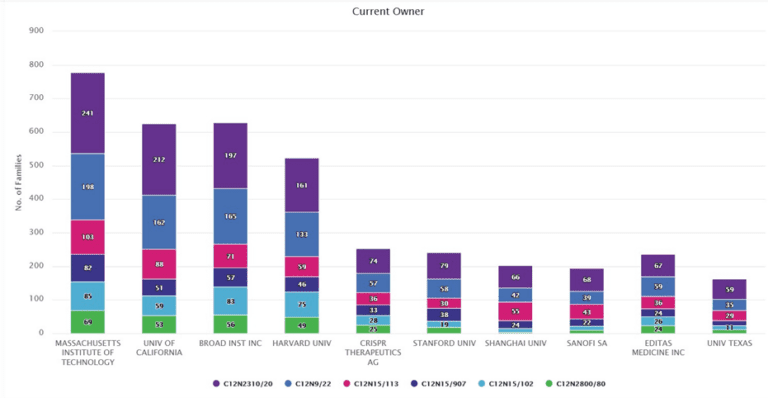Share
Share

CRISPR Leaders: AnalyZing Patenting Trends and Primary Areas of Innovation
Imagine if editing genetic code were as simple as editing a text document! With CRISPR technology, this has become a reality. CRISPR, which stands for Clustered Regularly Interspaced Short Palindromic Repeats, is a gene-editing tool that originated from a component of the bacterial immune system. CRISPR empowers scientists to edit genes with remarkable accuracy. Initially discovered in bacterial defenses against viruses, it’s now employed across various sectors, including agriculture and medicine.
Intrigued by the potential of CRISPR, we conducted a search using PatSeer and performed a company analysis based on the top CPC classes in the industry.

| CPC Classes | Class Definitions |
|---|---|
| C12N2310/20 | Clustered regularly interspaced short palindromic repeats [CRISPRs] |
| C12N9/22 | Ribonucleases RNAses, DNAses catalytic nucleic acids |
| C12N15/113 | Non-coding nucleic acids modulating the expression of genes |
| C12N15/907 | Genetic engineering in mammalian cells |
| C12N15/102 | Mutagenizing nucleic acids |
| C12N2800/80 | Vectors containing sites for inducing double-stranded breaks, e.g. meganuclease restriction |
Based on the above chart, we concluded that:
1. The Massachusetts Institute of Technology (MIT) and the University of California hold the highest number of patents in the field of CRISPR. Among them, MIT has a higher number of granted patent documents than the University of California.
2. The graph further shows that there is close competition between Stanford and Shanghai Universities. Stanford leads with 79 patents, while Shanghai University has 76 patents. Both universities mainly file under the CPCs C12N9/22 and C12N15/113. These CPCs relate to Ribonucleases and Nucleic acids that affect gene expression or its messenger transcription, such as Antisense nucleic acids and Catalytic nucleic acids, respectively.
3. The top four assignees – MIT, University of California, Broad Institute, and Harvard University – primarily focus their inventions on the co-suppression or gene silencing aspect of CRISPR technology (C12N2310/20) as compared to others.
4. Stanford University, Shanghai University, and the University of Texas are also actively filing patents in the area of co-suppression or gene silencing within CRISPR technology (C12N2310/20). While their patent counts aren’t as high as the top assignees, their numbers still place them among the top 10 players.
5. CRISPR enzymes are known to introduce double-stranded breaks. They can be integrated into various vectors to deliver CRISPR components for genome editing. The chart indicates that many players are filing patents under CPC C12N2800/80.
6. All players have been exploring genome editing techniques in mammalian cells, as indicated by the significant number of filings under class C12N15/907.
7. Finally, advancements in CRISPR technology research will greatly aid in curing various genetic disorders in humans.
In conclusion, the transformative potential of CRISPR technology is reflected not only in its diverse applications but also in the competitive landscape of patent ownership. The number of patents owned by these institutions demonstrates the profound interest and substantial investment in CRISPR, marking it as a pivotal frontier in genetic engineering.
